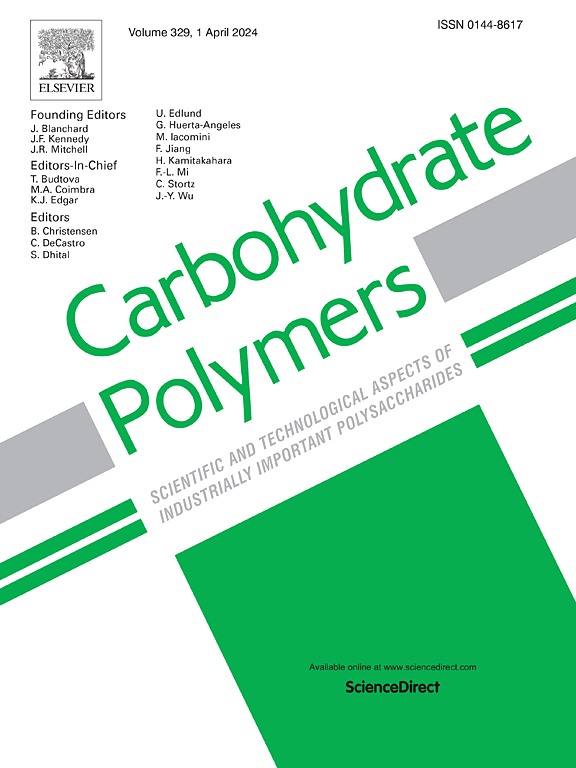基于纳米纤维素特殊孔隙结构的磁性纳米颗粒沉积:高效薄层吸波材料的制备与性能研究
IF 10.7
1区 化学
Q1 CHEMISTRY, APPLIED
引用次数: 0
摘要
开发高性能电磁波吸波材料是解决电磁污染的重要研究课题。纤维素是一种低成本、可生物降解的天然生物质材料,但其碳酸化产物的单一介质损耗机制限制了其吸波性能。在此,我们提出了一种新的策略,通过控制tempo氧化纤维素纳米纤维的碳化来构建具有非均匀孔隙几何形状(100-200 nm)的分层多孔纳米纤维。以二茂铁为铁源,通过一步退火工艺将磁性Fe/Fe3O4纳米颗粒包埋在这些孔隙中。退火复合材料(MF@C)具有双尺度结构优势:孔隙独特的非均质结构增强了电磁波的多次反射和界面极化,磁性纳米颗粒被均匀地限制在孔隙中,协同优化了阻抗匹配和磁介电损耗。MF@C-750在厚度仅为1.4 mm (RL <;-10 dB),有效吸收损耗为3.44 GHz。3.44 GHz有效吸收带宽(EAB)。这种性能归因于各向异性多孔碳框架和磁性纳米颗粒之间的协同相互作用。本研究将生物质衍生的各向异性多孔碳与受限磁性纳米颗粒相结合,为高效微波吸收剂的设计提供了一条可持续的途径。本文章由计算机程序翻译,如有差异,请以英文原文为准。
Magnetic nanoparticles deposition based on the peculiar pore structure of nanocellulose: preparation and properties of efficient thin-layer wave-absorbing materials
The development of high-performance electromagnetic wave-absorbing materials is an important research topic for solving electromagnetic pollution. Cellulose is a low-cost and biodegradable natural biomass material, but the single dielectric loss mechanism of its carbonation product limits the wave absorption performance. Here, we propose a new strategy to construct hierarchical porous nanofibers with heterogeneous pore geometries (100–200 nm) by controlled carbonization of TEMPO-oxidized cellulose nanofibers. Magnetic Fe/Fe3O4 nanoparticles were embedded in these pores by a one-step annealing process using ferrocene as the iron source. The annealed composite (MF@C) offers dual-scale structural advantages: the unique heterogeneous structure of pores enhances multiple reflections of electromagnetic waves and interfacial polarization, and the magnetic nanoparticles are uniformly confined in the pores, synergistically optimizing impedance matching and magnetic dielectric loss. The MF@C-750 achieves an excellent reflective loss of −35.04 dB at a thickness of only 1.4 mm (RL < -10 dB) and an effective absorption loss of 3.44 GHz. 3.44 GHz effective absorption bandwidth (EAB). This performance is attributed to the synergistic interaction between the anisotropic porous carbon framework and magnetic nanoparticles. This study combines biomass-derived anisotropic porous carbon with confined magnetic nanoparticles, providing a sustainable pathway for the design of efficient microwave absorbers.
求助全文
通过发布文献求助,成功后即可免费获取论文全文。
去求助
来源期刊

Carbohydrate Polymers
化学-高分子科学
CiteScore
22.40
自引率
8.00%
发文量
1286
审稿时长
47 days
期刊介绍:
Carbohydrate Polymers stands as a prominent journal in the glycoscience field, dedicated to exploring and harnessing the potential of polysaccharides with applications spanning bioenergy, bioplastics, biomaterials, biorefining, chemistry, drug delivery, food, health, nanotechnology, packaging, paper, pharmaceuticals, medicine, oil recovery, textiles, tissue engineering, wood, and various aspects of glycoscience.
The journal emphasizes the central role of well-characterized carbohydrate polymers, highlighting their significance as the primary focus rather than a peripheral topic. Each paper must prominently feature at least one named carbohydrate polymer, evident in both citation and title, with a commitment to innovative research that advances scientific knowledge.
 求助内容:
求助内容: 应助结果提醒方式:
应助结果提醒方式:


